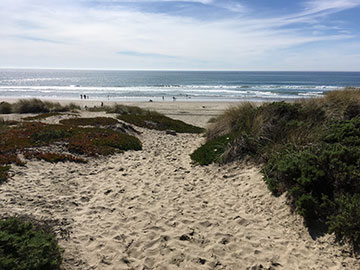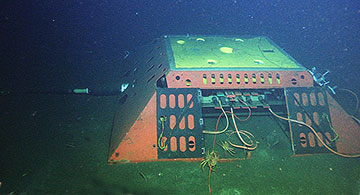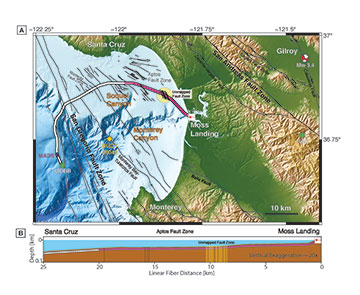Map of Monterey Bay showing the portion of a fiber optic cable (in pink) used temporarily for seismic monitoring, and the previously unmapped faults that were found (yellow circle). [Image: Lindsey et al., Science (2019)][Enlarge image]
Earth scientists around the world are devising ways to exploit the roughly one million kilometers of fiber optic cable spanning the oceans to create a vast seismic-monitoring network. In the latest development, U.S. researchers have used a cable under Monterey Bay in California to record the seismic waves generated by quite a small earthquake about 40 km away while revealing previously unmapped tectonic faults (Science, doi: 10.1126/science.aay5881).
The fruits of fiber
The vast majority of seismometers in use today are on land, which means that small earthquakes at sea are simply not detected. Seismometers can be placed on the seabed to record underwater quakes, but their deployment is time-consuming and expensive. The result is a very limited knowledge of tectonic faults beneath the ocean floor, which impedes efforts to reduce seismic hazard in coastal areas while leaving oil and gas deposits undiscovered.
Fiber optic–based sensors could instead allow scientists to exploit existing infrastructure—the cables that transmit phone calls and internet traffic from one side of the globe to the other. The idea is to send laser light down a fiber to record the series of tiny but distinctive contractions and expansions that a seismic wave will generate in the fiber as it passes through the earth.
One way to do this is to fire down extremely stable pulses from lasers positioned at either end of the fiber, and monitor the tiny variations in phase brought about by seismic changes in the optical path length. This approach has been tested by Giuseppe Marra of the National Physical Laboratory in the U.K. and colleagues, who reported last year having successfully used an undersea cable between Malta and Sicily to detect a magnitude 3.4 quake some 90 km from the fiber.
Thousands of sensors

Shoreline view of Monterey Bay, CA, from Moss Landing. [Image: N.J. Lindsey]
As Marra explains, because the technique exploits the transmitted power of the laser pulses, it has a high signal-to-noise ratio. This, he says, means being able to read out signals even after thousands of kilometers—therefore making it potentially well-suited to “implementing a global network using existing underwater infrastructure.” However, he adds, the setup offers only quite low spatial resolution.
In contrast, the scheme employed in the latest work has a more limited range—being most suited for applications on land or over the first few tens of kilometers from the shore, according to Marra. But it offers far higher resolutions.
Known as distributed acoustic sensing (DAS), this technique in effect turns a length of fiber optic cable into multiple sensors. It involves detecting scattered light from laser pulses that are very slightly modified as they travel along a fiber—thanks to variations in strain brought about by seismic stretching.
"Marra's approach interrogates the entire fiber length but treats the cable as a single-strain meter,” says Ajo-Franklin of Rice University in Houston, one of the authors of the new research. “In contrast, DAS can't reach across the ocean but provides thousands of sensing locations."
Ears to the ground
DAS is not a new technique, having been widely used by the oil and gas industry for around a decade to image wells. But Ajo-Franklin and colleagues have found it is also well-suited for seismic monitoring. In 2017, they carried out a six-month test on land using cable laid by the U.S. Department of Energy as part of a larger fiber testbed, showing they could monitor seismic tremors and environmental noise.
The apparatus they use to do this is an “interrogator”—a commercial device containing a stable laser, an interferometer and processing hardware. In the latest test, carried out last year, Ajo-Franklin and Nathaniel Lindsey of the University of California, Berkeley hooked up the device, onshore, to the end of a 50-km-long fiber optic cable that runs along the bottom of Monterey Bay. By measuring the backscattered light at 2-m intervals along a 20-km stretch of the cable, they in effect transformed the fiber into 10,000 motion sensors.
Owned by Monterey Bay Aquarium Research Institute (MBARI), the cable usually ferries data from a number of geophysical instruments sitting on the seabed. But thanks to a stop for maintenance, Lindsey and Ajo-Franklin, working with MBARI’s Craig Dawe, were able to use the length of fiber to make seismic measurements continuously for four days. It was during that time that their sensors picked up the seismic waves from a magnitude 3.4 earthquake under Gilroy, roughly 40 km from the coast.
Fault plotting

The Monterey Accelerated Research System (MARS) cabled observatory is connected to shore by a 52-km undersea cable that carries data and power. About 20 km of the cable was used to test photonic seismology on the seafloor. [Image: Copyright MBARI, 2009]
The researchers used those seismic waves to map tectonic faults under the bay. They did so by plotting the variation of strain rate in both time and space—measuring length changes down to one part in a billion—and then looking to see at which points along the cable seismic energy was re-radiated—an effect that they interpreted as being due to submarine faults converting one type of seismic wave into another. Doing so, they observed a number of recently mapped faults about 15 km along the fiber. However, they also identified several previously unmapped faults a few kilometers closer to the coast.
In addition, the researchers used their sensors to record the seismicity generated by ocean waves. They found that their instrument, in line with data from surface buoys, recorded a bigger signal during storms.
To deploy their sensors on a large scale the scientists will have to show that they can be used in “lit” fiber optic cables—those that are carrying internet and other data. To that end, Lindsey and Ajo-Franklin are currently carrying out experiments to establish whether or not they can send and receive the laser pulses they need without interfering with other data channels. They are also planning to use their sensors to monitor earthquake swarms in southern California.

